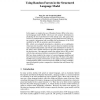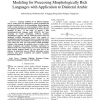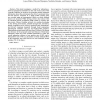2047 search results - page 180 / 410 » The limits of speech recognition |
NIPS
2004
13 years 11 months ago
2004
In this paper, we explore the use of Random Forests (RFs) in the structured language model (SLM), which uses rich syntactic information in predicting the next word based on words ...
ACL
1998
13 years 11 months ago
1998
Miscommunication in speech recognition systems is unavoidable, but a detailed characterization of user corrections will enable speech systems to identify when a correction is taki...
ICASSP
2010
IEEE
13 years 10 months ago
2010
IEEE
Class posterior distributions have recently been used quite successfully in Automatic Speech Recognition (ASR), either for frame or phone level classification or as acoustic featu...
TASLP
2008
13 years 10 months ago
2008
Language modeling for an inflected language such as Arabic poses new challenges for speech recognition and machine translation due to its rich morphology. Rich morphology results i...
TITS
2011
13 years 5 months ago
2011
—This study investigates a method for estimating a driver’s spontaneous frustration in the real world. In line with a specific definition of emotion, the proposed method inte...



